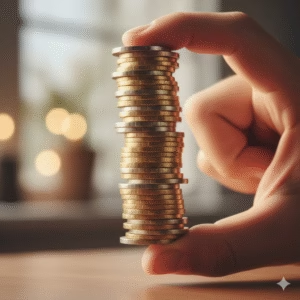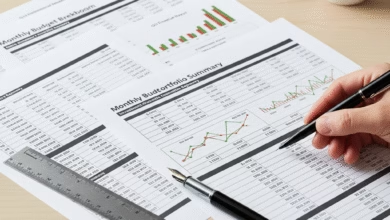Why does the price of gold rise during times of economic instability?
Understand how the price of gold rises during times of economic crisis

When the stock market is plummeting, headlines are filled with panic, and the economic future looks bleak, a strange thing happens. While most investments are bleeding red, one ancient asset often begins to glow: gold.
For centuries, investors, central banks, and everyday people have instinctively flocked to this yellow metal during times of crisis. It’s a phenomenon so predictable it has its own name in financial circles: the “flight to safety” or the “fear trade.”
But why?
In a high-tech world of digital currencies, billion-dollar corporations, and complex financial instruments, why does humanity’s oldest form of money become the most sought-after asset when things go wrong?
The answer isn’t just tradition; it’s a powerful combination of economics, psychology, and 5,000 years of history. Gold rises during instability because it is the antithesis of the very things that are failing.
This guide will break down the exact reasons why gold acts as a financial safe harbor and what its performance tells you about the health of the global economy.
Disclaimer: This article is for informational and educational purposes only. It is not intended as financial, investment, or legal advice. All investments carry risk, and you should consult with a qualified professional before making any financial decisions.
What Does “Safe Haven Asset” Actually Mean?

Before we can understand why gold is a safe haven, we must first define what that term means.
A “safe haven” is an investment that is expected to retain or even increase its value during times of market turbulence or economic crisis. When “risk assets” like stocks and real estate are falling, investors sell them and move their capital into safe havens to protect their wealth.
To qualify as a safe haven, an asset generally needs three key characteristics:
-
High Liquidity: It can be bought and sold quickly and easily without a significant loss in value.
-
No Counterparty Risk: This is the most crucial concept. The value of the asset does not depend on another party’s promise or solvency.
-
Intrinsic Value: It has a history of being a reliable “store of value.”
Let’s break down “counterparty risk” because it’s the key:
-
A share of stock (like Apple) has counterparty risk. Its value depends on Apple’s ability to innovate and generate profits. If Apple fails, the stock is worthless.
-
A corporate bond has counterparty risk. Its value is a promise from a company to pay you back. If the company goes bankrupt, you lose your money.
-
Even cash in the bank has a (very small) counterparty risk. You are trusting the bank to hold your money. If the bank fails, you are reliant on FDIC insurance.
A gold bar held in your hand has zero counterparty risk. It is not a promise from anyone. It has no CEO, no board of directors, and no government liability. Its value is inherent, tangible, and globally recognized.
This independence is what makes it the ultimate safe harbor.
The “Gold Standard” of Fear: Why Gold Shines During Inflation
The single biggest driver of gold prices during economic instability is inflation.
Inflation is the decline of a currency’s purchasing power. It’s the reason your grandfather could buy a car for $2,000 and today a new car costs $40,000. The car didn’t get 20 times better; the dollar got 20 times weaker.
So, how does instability cause inflation?
During a crisis (like a pandemic or a financial meltdown), governments and central banks (like the Federal Reserve) react by injecting massive amounts of money into the economy to prevent a total collapse. They do this through stimulus checks, bailouts, and a policy called “Quantitative Easing” (QE)—all ofwhich are polite terms for creating new money out of thin air.
While this can help in the short term, it floods the market with new dollars, diluting the value of every dollar already in existence.
This is where gold comes in.
You can print trillions of dollars. You cannot print more gold.
The supply of gold is finite. It can only be increased by the difficult, expensive, and slow process of mining (which adds only ~1.5% to the global supply each year).
When investors see the government “turning on the money printer,” they know their cash savings are about to lose value. They seek to trade their diluting paper currency for a finite, tangible asset that cannot be debased. As millions of investors try to buy a limited supply of gold, its price, measured in those weaker dollars, naturally skyrockets.
The classic example is the 1970s “Stagflation.” The economy was stagnant, unemployment was high, and inflation was raging. The stock market went nowhere for a decade. But gold? It went on one of the most incredible bull runs in history, rising from $35/oz to a peak of $850/oz—a gain of over 2,300%.
Geopolitical Instability: How Wars and Conflicts Fuel Gold’s Rally
War, trade disputes, and geopolitical conflict are other major forms of instability that send gold prices higher. The mechanism here is twofold:
1. The Disruption of Supply Chains
Conflicts, especially in critical regions like the Middle East or Eastern Europe, disrupt the global flow of essential commodities. When the supply of oil, gas, or grain is threatened, the price of everything (from your gas bill to your groceries) goes up. This creates massive inflation, which (as we just discussed) is rocket fuel for gold.
2. The “Flee” Asset
In a severe geopolitical crisis, the very stability of governments can come into question.
-
What happens if a country’s government collapses? Their currency and bonds become worthless overnight.
-
What happens if a country is suddenly cut off from the global financial system by sanctions? They may be unable to use their U.S. Dollar reserves.
Gold is apolitical and borderless. It has been recognized as a store of value in virtually every culture on Earth for millennia. It is the only financial asset that is not controlled by any single government or bank.
If you are forced to flee a country in turmoil, you can’t carry your house or your stock portfolio with you. But you can carry gold, knowing that you can exchange it for local currency whether you land in London, Mumbai, or Tokyo. This makes it the ultimate “crisis insurance” asset.
Gold vs. The Stock Market: A Negative Correlation Explained

For most investors, the “economy” is the stock market (e.g., the S&P 500). During times of instability, the stock market falls, often dramatically.
A recession or financial crisis means:
-
Corporate profits are falling.
-
Companies are laying off workers.
-
Consumers are scared and spending less.
This leads to a panic-driven “risk-off” environment. Investors sell their “risk assets” (stocks) in a desperate search for safety. Where does that money go?
A large portion of it flows directly into safe havens, with gold and U.S. Treasury bonds being the primary recipients.
This creates a powerful “negative correlation.”
-
When stocks go up (times are good, people are greedy), gold often lags behind.
-
When stocks go down (times are bad, people are fearful), gold often goes up.
This is not a coincidence. It is the same event (fear) causing two opposite reactions. Think of it as a financial seesaw.
A perfect example is the 2008 Global Financial Crisis. From its peak in 2007 to its low in 2009, the S&P 500 lost over 50% of its value. It was a bloodbath. During that same approximate period, the price of gold rallied, acting as a crucial “portfolio insurance” for those who held it. It cushioned the blow and preserved their wealth.
The Psychology of Fear: Understanding the “Fear Trade”
We cannot discount the simple, powerful human emotion of fear. Financial markets are not perfectly rational calculators; they are driven by the collective greed and fear of millions of people.
-
Greed Drives Bull Markets: When stocks are rising, people are driven by FOMO (Fear Of Missing Out). They pile into assets, hoping to get rich.
-
Fear Drives Bear Markets: When markets are crashing, people are driven by FOLM (Fear Of Losing Money). They panic-sell, hoping to preserve whatever they have left.
Gold is the ultimate “fear asset.” It is the financial equivalent of a bomb shelter. It has a 5,000-year history of protecting wealth. It’s simple, tangible, and universally understood.
When people are terrified of the complex financial system failing, they don’t buy complex derivatives or tech stocks. They buy gold.
This creates a self-fulfilling prophecy.
-
A crisis begins.
-
A few smart investors (and central banks) start buying gold.
-
The price starts to rise.
-
The financial media reports, “Gold Prices Hit New Highs as Fears Grow.”
-
This makes the general public more scared and triggers their herd instinct to buy gold.
-
This massive new demand sends the price even higher, reinforcing the narrative that “gold is the only safe place.”
The Hidden Player: Why Central Banks Are Buying Gold in Droves
It’s not just individual investors who are part of the “fear trade.” The biggest players in the game are central banks.
For decades, the world’s central banks have held most of their reserves in U.S. Dollars. The dollar is the world’s “reserve currency,” used for international trade.
However, in recent years, this has created two massive risks for them:
-
Inflation Risk: If the U.S. Federal Reserve prints trillions of dollars, the value of all the dollar reserves held by other countries (like China or India) declines.
-
Geopolitical Risk: If a country has a political disagreement with the United States, it can be sanctioned and cut off from its own dollar reserves.
The solution? De-dollarization.
Central banks around the world (especially in China, Russia, India, Turkey, and Poland) have been buying physical gold at a record pace. They are diversifying their national treasuries away from the U.S. Dollar and into an apolitical, tangible asset that they can hold in their own vaults.
This is instability at the highest possible level. These banks are hedging against the risk of the entire U.S. dollar-based financial system. This massive, consistent buying creates a strong “floor” for the price of gold and adds significant upward pressure when new crises emerge.
What About “Digital Gold”? Bitcoin vs. Gold in a Crisis

In the 21st century, a new challenger for the “safe haven” throne has emerged: Bitcoin, often called “Digital Gold.”
The theory is sound: Bitcoin is also scarce (limited to 21 million coins), decentralized, and not controlled by any government. So, shouldn’t it also rise in a crisis?
So far, the evidence is mixed.
In its short 15-year history, Bitcoin has often behaved more like a “risk-on” tech stock than a “risk-off” safe haven. In the COVID-19 panic of March 2020, Bitcoin crashed harder than the stock market. Why?
-
Lack of History: Gold has a 5,000-year track record. When a true, system-ending panic hits, investors run to the proven exit, not the experimental one.
-
Perceived Use: Bitcoin is still seen by most of the world as a high-growth, speculative technology, not a stable store of value.
-
Liquidity: In a “cash is king” panic, investors sell everything to get dollars, and Bitcoin is often one of the first things sold.
Bitcoin may one day mature into a true safe haven, but for now, gold remains the undisputed champion.
How to Think About Gold in Your Own Financial Plan
Given all this, should you sell all your stocks and put everything into gold, anticipating the next crisis?
Absolutely not.
It’s crucial to understand that gold is not a wealth-creation tool. It’s a wealth-preservation tool.
Warren Buffett famously dislikes gold because it’s a “pet rock.” It doesn’t pay a dividend like a stock, nor does it pay interest like a bond. It just sits there. During strong economic booms, gold is often the worst performing asset in a portfolio.
This is its “opportunity cost.”
The best way to think of gold is as portfolio insurance.
You don’t buy homeowner’s insurance hoping your house burns down. You buy it in case it does, to protect you from financial ruin.
You don’t buy gold hoping for an economic collapse. You hold a small portion (many experts suggest 5% to 10% of your portfolio) in case it does. Its job is to be the one asset that zigs when all your other assets (stocks) are zagging. This cushions the blow, reduces your portfolio’s overall volatility, and gives you a stable asset to sell in a crisis to buy other, cheaper assets.
In short, gold rises in a crisis because it is the ultimate anchor—a tangible, finite, and trusted asset in a financial world built on debt, promises, and digital code.





